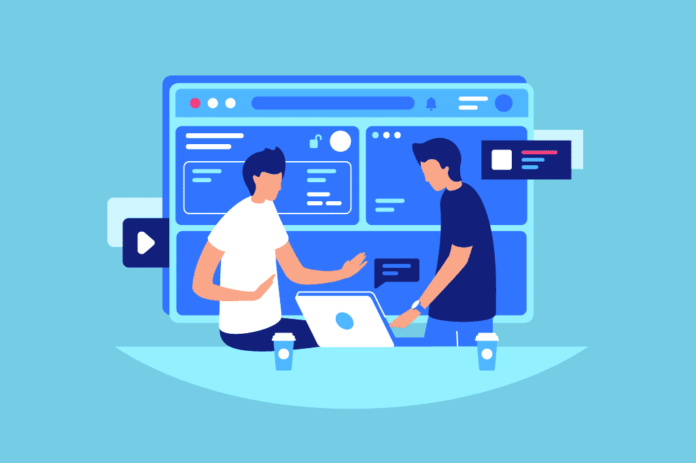New product development is a multi-step process that starts with ideation where we think of the initial idea, and ends with a release of a fully-functioning product.
You may find different frameworks for the product development process in books or online, but the core stages of development tend to stay the same.
Table of Contents
What is product development? The key stages
You can think of the new product development process as a project. There are stakeholders, the product owner (somewhat similar to a project manager), and the development team. You have a budget, timeframes, and a list of expected deliverables. And there are clear steps you must complete to succeed.
The goal of new product development is to create from scratch a new way of address customer pains. Here are the key stages for successful product development.
Ideation
Ideation or idea generation is the creative part of the process where we brainstorm ideas, review customers’ needs and unmet demands, analyze competitor’s use cases, and think of the innovative solutions we could offer.
As you go through the ideation stage, consider the following factors:
- Target audience and markets
- Competitor solutions
- Functionality of the future product
- Resources available for the project
- Preliminary design criteria
If you find yourself with several ideas but have to choose one, perform an idea screening to identify and eliminate the least attractive and feasible concepts. Companies do this using many different techniques and methods to help them, such as SWOT analysis. If you struggle with making a decision, we suggest creating Minimum Viable Products (MVPs) for each idea to have a quick test with potential clients.
On top of finding the best idea out of many, an MVP test can give you more insight into what clients want because they will be actively sharing their thoughts after the test.
Product definition
Stage two is all about finalising your thoughts, ideas, requirements, expected deliverables, and acceptance criteria. By the end of this stage, you should have complete clarity over what product you will be creating and what resources and timeframes you have to bring the vision to life.
What needs to be done or thought through during product definition:
- Business analysis: plan the distribution and preliminary marketing strategies (for example, what promotion channels will be used to advertise the product), run a deeper competitor analysis; review internal processes.
- Write a value proposition where you identify what issues the product is solving and how.
- KPIs and success metrics. There has to be a solid definition of done for deliverables and a metric system that will be used to track progress and evaluate the final product.
- Product roadmap. Developing a new product is a project, and projects have to be completed within timeframes. Create a product roadmap that highlights key deadlines and milestones. The roadmap will be later used for monitoring progress and planning.
Make sure you have formal approvals from all key stakeholders for anything that you agree on at this point. As the product development progresses, someone might want to deviate and suggest changes that would not be in line with the plan. Some of those change requests will be valid and useful. If any of the suggestions and change demands represent a risk to the process, you will be able to decline them with solid reasoning.
Prototyping and design
If you’ve already created MVPs (for example, a landing page or a functioning MVP), then you can work on top of them. If not, start prototyping your future product. This can be as simple as a drawing. The result of prototyping will be your MVP.
The goal of prototyping is to get a feel for the future solution, spot potential risks and bottlenecks, and agree on the general layout.
Next comes the design phase which is more in-depth and should consider all identified future functionality while keeping your target audience in mind. The design phase can take a while with several iterations and going back and forth. It’s important not to rush the process because design logic will influence the following development steps and will partially define how the product is built.
Tip: engage different groups of stakeholders in the design process for best results. It might take more time in the moment but save you many hours in the future.
If you partially outsource your product development, you’ll need to check with the other party to see if they can actually deliver your design. As for the management, it’s best to get them on board and check-in with them at every stage (even if you’ve approved the plan in advance). The last thing you need is to be surprised by one of your key stakeholders blocking your process for no apparent reason.
Product development
This is the step where the main action takes place. Here, you will be working on the actual product that will be delivered to the market.
Many technical startups use the product development strategy based on Scrum. Scrum is a project management framework that works in small development cycles called sprints.
Each sprint is a mini-project on its own. It lasts from one to four weeks, during which the team picks a group of tasks that they work on during the sprint. By the end of the period, all tasks have to be completed and tested and be ready to be shipped to clients. Such a process allows for more frequent releases, constant iterations, and feedback gathering.
The development process in your company can look different but it’s important that you come to the main goal of having a working product that clients like and can use to solve their problems.
Testing and QA
QA and testing are essential for a successful new product development process.
The features you’ve developed and the design you’ve created must work properly. If they don’t, you risk your reputation. Plus, you will have a much harder time selling the product if the first version was a failure.
Testing happens at the final stages of product development, so the temptation is high to rush through it and jump to release. This is a mistake because the damage a flawed product can have on your business will far outweigh the potential benefits of a product’s earlier release.
Product release and maintenance
The final and the most exciting phase of the new product development is the release to the market.
Prepare for the product launch in advance:
- Send internal communications with detailed information about the product, main benefits, and selling points. Add links to guides and other useful materials.
- Run meetings and training for anyone who will work with the product (even indirectly).
- Have your marketing communication ready and scheduled.
- Add a landing page to the website dedicated to the new product.
After the launch, focus on collecting feedback, fixing any bugs that managed to slip through, and adapting your long-term product roadmap to see what you should be adding next in the functionality and/or design.
Partner with Emphasoft to develop a new product
Whether you are a startup or an established business with a lengthy product portfolio, passing the new product development to Emphasoft will save you time and resources. Focus on the key strategic activities of your business and leave the rest to the professionals.
The Emphasoft team consists of 170+ technical specialists who can begin working on your projects within 3 days. We have already successfully delivered 135+ projects in the past, so we know what we’re doing and can deliver high-quality results within your timeframes and budget.





